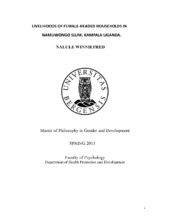| dc.description.abstract | This study focuses on the livelihoods of female-headed households (FHHs) in Namuwongo slum in Kampala Uganda. The trajectory of FHHs to Namuwongo slum, their livelihood challenges, and their livelihood strategies for survival are explored. Data material was collected through qualitative methods, such as in-depth interviews and observations. The Sustainable Livelihood Approach and Empowerment were adopted as theoretical frameworks for analysis. There are a number of reasons as to why some slum households are female headed. These reasons include widowhood and separation and divorce. Extreme poverty appears is a common feature among FHHs. Despite low levels of education and lack of regular employment, leaving the FHHs vulnerable; this study demonstrates that their ability to improvise alternatives for their survival is surprisingly strong. FHHs both run informal business and involve themselves in casual work to create income for their households. FHHs also use human capital in the form of family labor as a way of securing financial capital. Some also involve children in income-generating activities as a livelihood strategy. Social capital among the FHHs is significant because they share information, ideas, and livelihood resources to build their assets and find solutions to their problems. Neighbours and relatives are also used as a strategy to lessen financial constraints. The female heads of households are members of local savings groups and projects, such as the sisterhood project that offer financial assistance to their households. These projects also aid them in sending their children to school. The results of this study indicate that while FHHs manage to get by, they face some challenges. These include limited resources, lack of decent housing and infrastructure, and health risks entailed in living in the slum, such as lack of enough clean and piped water, poor drainage and flooding after heavy rainfalls. | en_US |
